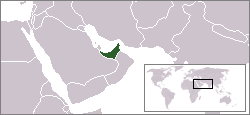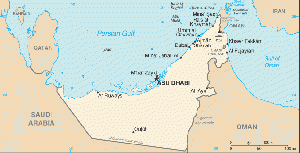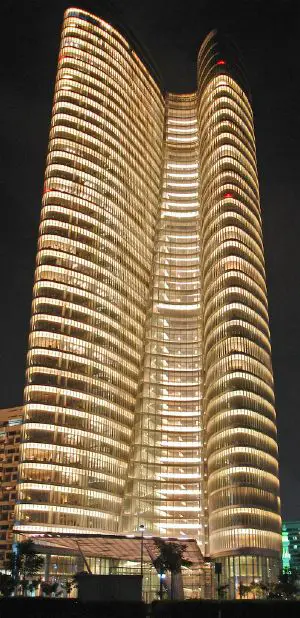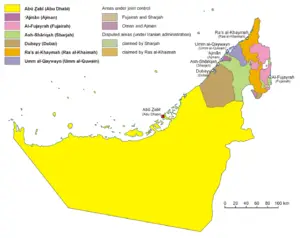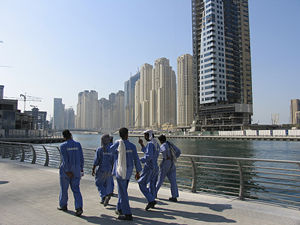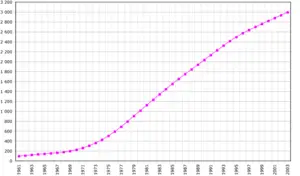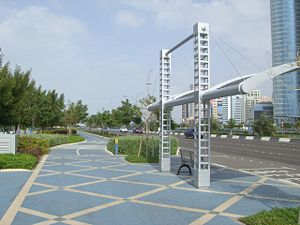| دÙÙØ© اÙØ¥Ù
ارات اÙعربÙØ© اÙÙ
تØدة Dawlat al-ImÄrÄt al-âArabÄ«yah al-Muttaḥidah United Arab Emirates |
||||||
|---|---|---|---|---|---|---|
|
||||||
| Motto: اÙÙÙ , اÙÙØ·Ù , اÙرئÙس Allah, al-Waá¹an, al-Ra'Ä«s (Arabic) "God, The Homeland, President" |
||||||
| Anthem:Â Ishy Bilady |
||||||
| Capital | Abu Dhabi | |||||
| Largest city | Dubai | |||||
| Official languages | Arabic | |||||
| Ethnic groups | 16.5% Emirati, 23% Other Arabs, Iranian, 60.5% South Asian, Indian, Pakistani, Bangladeshi, Chinese, Filipino, Thai, Westerners (2009)[1][2] | |||||
| Demonym | Emirati[2] | |||||
| Government | Federal presidential system and elective constitutional monarchy | |||||
| Â -Â | President | Khalifa bin Zayed Al Nahyan | ||||
| Â -Â | Vice President and Prime Minister | Mohammed bin Rashid Al Maktoum | ||||
| Legislature | Federal National Council | |||||
| Sovereignty | End of special treaty with the United Kingdom | |||||
| Â -Â | Constitution | December 2, 1971Â | ||||
| Area | ||||||
|  - | Total | 83,600 1 km² (116th) 32,278 sq mi |
||||
|  - | Water (%) | negligible | ||||
| Population | ||||||
| Â -Â | 2010Â estimate | 8,264,070[3]Â (93rd) | ||||
| Â -Â | 2005Â census | 4,106,427Â | ||||
|  - | Density | 99/km² (110th) 256/sq mi |
||||
| GDPÂ (PPP) | 2010Â estimate | |||||
| Â -Â | Total | US$182.876 billion[4]Â | ||||
| Â -Â | Per capita | US$36,175.966[4]Â | ||||
| GDP (nominal) | 2010Â estimate | |||||
| Â -Â | Total | US$252.736 billion[4]Â | ||||
| Â -Â | Per capita | US$49,995.307[4]Â | ||||
| Gini (2008) | 36 | |||||
| Currency | UAE dirham (AED) |
|||||
| Time zone | GMT+4 (UTC+4) | |||||
|  - | Summer (DST) | not observed (UTC+4) | ||||
| Internet TLD | .ae, ا٠ارات. | |||||
| Calling code | [[+971]] | |||||
| 1 | The country's exact size is unknown because of disputed claims to several islands in the Persian Gulf, the lack of precise information on the size of many of these islands and that most of its land boundaries, especially with Saudi Arabia, remain un-demarcated. | |||||
The United Arab Emirates (also the UAE or the Emirates) is a Middle Eastern country situated in the southeast of the Arabian Peninsula in Southwest Asia on the Persian Gulf, comprising seven emirates: Abu Dhabi, AjmÄn, Dubai, Fujairah, Ras al-Khaimah, Sharjah, and Umm al-Quwain.
Before 1971, they were known as the "Trucial States" after a nineteenth century truce between Britain and several Arab sheikhs. The name "Pirate Coast" was used from the eighteenth to early twentieth centuries.
The United Arab Emirates has huge proven oil reserves, expected to last well over 150 years. This oil wealth has enabled the federation to develop rapidly in a little over 30 years, from a collection of poor desert-coast sheikdoms to a wealthy, modern state, with relatively high human development.
However, politically, free assembly and association are restricted, and the rights of workers are limited. Despite the federation's reputation for religious tolerance, expatriates accused of so-called religious crimes may be deported without appeal, and Sharia law punishments continue.
Geography
The United Arab Emirates borders the Gulf of Oman and the Persian Gulf, between Oman and Saudi Arabia. It is a strategic location along the southern approaches to Strait of Hormuz, a vital transit point for world crude oil.
With a land area of 32,278 square miles (83,600 square kilometers), the territory is slightly smaller than Maine in the United States. The terrain is a flat, barren coastal plain merging into rolling sand dunes of vast desert wasteland with mountains in the east. The highest point is Jabal Yibir at 5,000 feet (1,527 meters).
Sunny, blue skies can be expected throughout the year. The climate is hot, with average January (winter) temperatures of 65°F (18°C) rising to July (summer) levels of 92°F (33°C). The coast is humid, while the interior is dry and hot. Average annual rainfall is three to four inches (75 mm to 100 mm). Sandy winds blow from the north and northwest during winter and spring.
Desert conditions limit vegetation to a few wild shrubs. Date palms and mangos are cultivated at oasis, as well as wheat and millet. Since 1966 more than 70 million acacias, eucalyptus trees, and palm trees have been planted. Indigenous wildlife includes the hyena, fox, wildcat, panther, gazelle, antelope, quail, and bustard.
The main natural resources are oil and natural gas; it has the world's fourth-largest reserves, which are concentrated in Abu Dhabi. The soil is almost entirely sandy, and less than one percent of the land area is suitable for cultivation.
Natural hazards include frequent sand and dust storms, in some cases reducing visibility down to a few feet. Environmental issues include lack of natural freshwater resources, desertification, beach pollution from oil spills, and air pollution from burning fossil fuels for electricity production. Conservation efforts have saved the desert oryx and gazelle, as well as the endangered dugong, or sea cow, which is found along the coast. The UAE has been identified as a hub of international illegal wildlife commerce. Most of the nationâs water comes from desalinization plants.
Abu Dhabi is the capital of the emirate of the same name, is largest of the seven emirates, and is the capital of the United Arab Emirates. It is said by some to be the richest city in the world. The city lies on a T-shaped island jutting into the Persian Gulf from the central western coast. An estimated 1.8 million people lived there in 2006, with about an 80 percent expatriate population.
History
Little is known about pre-Islamic culture in the southeast Arabian Peninsula, except that many ancient towns in the area were trading centers between the Eastern and Western worlds. People of various cultures have lived in the Arabian Peninsula for more than 5,000 years. The Dilmun culture, along the Persian Gulf coast (c. 3000â1600 B.C.E.), was contemporaneous with the Sumerians and ancient Egyptians, and most of the empires of the ancient world traded with the states of the peninsula. Except for a few cities and oases, the harsh climate prevented much settlement. A significant event between 3000 and 2500 B.C.E. was the domestication of the one-humped camel, or dromedary, in the southern part of the Arabian Peninsula. By 1000 B.C.E., such camels were important in the caravan trade. Before Mohammad's birth, the people in this region were idol worshipers, who worshiped "Bajar."
In 325 B.C.E., Alexander the Great sent a fleet from India to explore the gulf. Alexander's successors did not control the area long enough to make the gulf a part of the Greek world. By about 250 B.C.E., the Greeks lost all territory east of Syria to the Parthians, a Persian dynasty in the East.
From the third century C.E., the Persian Sassanians, who held the area until the rise of Islam four centuries later, established agricultural colonies and engaged nomadic tribes to protect their western flank from the Romans.
Judaism and Christianity arrived from Jewish and Christian tribes in the Arabian Desert, from Ethiopian Christians to the south, and from Mesopotamia, where Jewish and Christian communities flourished. The popularity of Christianity and Judaism paled, however, when compared with the enthusiasm with which the Arabs greeted Islam in the seventh century.
For centuries, the region that became the United Arab Emirates was embroiled in dynastic disputes. In the early eighteenth century, the Al Abu Falasa clan of Bani Yas clan established Dubai, which remained a dependent of Abu Dhabi until 1833.
The region became known as the Pirate Coast, from the seventeenth into the nineteenth century, as raiders based there harassed foreign shipping, requiring European and Arab navy patrols. Early British expeditions to protect the India trade from raiders at Ras al-Khaimah led to campaigns against that headquarters and other harbors along the coast in 1819. The next year, a general peace treaty was signed to which all the principal sheikhs of the coast adhered. Raids continued intermittently until 1835, when the sheiks agreed not to engage in hostilities at sea. In 1853, they signed a treaty with the United Kingdom, under which the sheiks (the "Trucial Sheikhdoms") agreed to a "perpetual maritime truce." It was enforced by Britain, and disputes among sheiks were referred to the British for settlement.
Primarily in reaction to the ambitions of other European countries, Britain and the Trucial Sheikdoms established closer bonds in an 1892 treaty, similar to treaties entered into by Britain with other Persian Gulf principalities. The sheiks agreed not to dispose of any territory except to Britain and not to enter into relationships with any foreign government other than Britain without its consent. In return, the British promised to protect the Trucial Coast.
In 1955, Britain sided with Abu Dhabi in the latter's dispute with Saudi Arabia over the Buraimi Oasis and other territory to the south. A 1974 agreement between Abu Dhabi and Saudi Arabia would have settled the Abu Dhabi-Saudi border dispute; however, the agreement has yet to be ratified by the emirates government and is not recognized by the Saudi government. The border with Oman also remains officially unsettled, but the two governments agreed to delineate the border in May 1999.
In 1968, Britain announced its decision, reaffirmed in March 1971, to end the treaty relationships with the seven Trucial Sheikhdoms which had been, together with Bahrain and Qatar, under British protection. The nine attempted to form a union of Arab emirates, but by mid-1971 they were unable to agree on terms of union. Bahrain became independent in August, and Qatar in September 1971. When the British-Trucial Sheikhdoms treaty expired on December 1, 1971, they became fully independent. On December 2, 1971, six of them entered into a union called the United Arab Emirates. The seventh, Ras al-Khaimah, joined in early 1972.
Emirates sent forces to liberate Kuwait during the 1990â1991 Persian Gulf War.
On November 2, 2004, the Emiratesâ first and only president, Sheikh Zayed bin Sultan Al Nahyan, died. He had been the ruler of Abu Dhabi and president of the federation for over 30 years (1971-2004). His eldest son Khalifa bin Zayed al Nahyan succeeded him as Ruler of Abu Dhabi. The federationâs Supreme Council of Rulers elected Khalifa bin Zayed Al Nahyan as federal president. Mohammed bin Zayed al Nahyan succeeded Khalifa as Crown Prince of Abu Dhabi.
Government and politics
The politics of the United Arab Emirates take place in a framework of a federal presidential elected monarchy. It is a federation of seven absolute monarchies: The emirates of Abu Dhabi, Ajman, Fujairah, Sharjah, Dubai, Ras al-Khaimah and Umm al-Qaiwain. The ruler of Abu Dhabi is the president of the United Arab Emirates, and the ruler of Dubai is the prime minister.
Administratively, the United Arab Emirates is a federation of seven emirates, each with its own ruler. Each ruler sets the pace at which local government in each emirate evolves from traditional to modern. Under the provisional constitution of 1971, each emirate reserves considerable powers, including control over mineral rights (notably oil) and revenues. In this milieu, federal powers have developed slowly.
The constitution established the positions of president (chief of state) and vice president, each serving five-year terms; a Council of Ministers (cabinet), led by a prime minister (head of government); a supreme council of rulers; and a 40-member National Assembly, a consultative body whose members are appointed by the emirate rulers.
The supreme council, comprising individual rulers of the seven emirates, elects the president and vice-president every five years. Shaikh Zayyed bin Sultan Al Nahayan was president from its foundation until his death on November 2, 2004. His eldest son, Khalifa bin Zayed Al Nahayan, was president in 2007. Although unofficial, the presidency is in fact hereditary to the Al-Nahyan clan of Abu Dhabi, and the premiership is hereditary to the Al-Maktoom clan of Dubai. The supreme council also elects the Council of Ministers.
The Federal National Council (Majlis Watani Ittihad) has 40 members, half appointed by the rulers of the constituent states and the other half elected to serve two-year terms, with only advisory tasks. The United Arab Emirates does not allow political parties. The first election occurred during mid-December 2006.
Rapid modernization, enormous strides in education, and the influx of a large foreign population have changed society but have not altered the traditional political system, whereby the rulers hold power on the basis of their dynastic position. The emirates, in 2007, seemed far from the emergence of any meaningful political life, which usually accompanies increased wealth. Huge government spending, free access to education, and to health services, as well as subsidized primary commodities, has diverted attention from politics.
The Supreme Court consists of a president and up to five judges appointed by the president. The Supreme Court has jurisdiction over federal-emirate and inter-emirate disputes. It may try cases of official misconduct involving cabinet and other senior federal officials. Courts of first instance adjudicate civil, commercial, criminal, and administrative cases. Judgments of these courts can be appealed to the Supreme Court. Shariâa (Islamic law) is the basis of all legislation. Most citizens follow the Maliki legal school, but a minority follow the Hanbali and Shafii schools. The Twelver Imam legal school of Shia Muslims also has adherents. Punishments include flogging and stoning to death.
Exclaves and enclaves
Five emirates have one or more exclaves, and there are two areas under joint controlâone is controlled by Oman and Ajman, the other by Fujairah and Sharjah. There is an Omani enclave surrounded by emirates territory, known as Wadi Madha, located halfway between the Musandam peninsula and the rest of Oman, in the Emirate of Sharjah. Within the enclave is an emirates exclave called Nahwa, also belonging to the Emirate of Sharjah.
Human rights
Although the government has made some advances in the protection of human rights, the U.S. Department of State notes that the federation does not have democratically elected institutions, citizens do not have the right to change their government, and there are no political parties. Free assembly and association are restricted, and the rights of workers are limited. The Barnabas Fund notes that the Dubai emirate removed the right of appeal against deportation by expatriates accused of so called religious crimes, such as trying to convert a Muslim to another religion. Amnesty International notes the mass detainment of 250 persons related to the United States-led War on Terror, the ill treatment of prisoners in prison, and the continued use of flogging and the death penalty.
Military
The Trucial Oman Scouts, long the symbol of public order on the coast and commanded by British officers, were turned over to the United Arab Emirates in 1971. Armed forces, consisting of 65,000 troops, are headquartered in Abu Dhabi and are responsible for the defense of the seven emirates. The military relies heavily on troops from other Arab countries and Pakistan. The officer corps is composed almost exclusively of emirates nationals.
The air force has about 3,500 personnel. Equipment includes U.S. F-16 multi-role fighter aircraft, Mirage 2000s, British Hawk aircraft, and French helicopters. The air defense has a Hawk missile program for which the United States provided training, and has taken delivery of two of five Triad I-Hawk batteries. The navy has more than 2,000 personnel, 12 well-equipped coastal patrol boats, and eight missile crafts.
The federation sent forces to help Kuwait during the 1990-91 Gulf War. It dispatched an infantry battalion to the United Nations force in Somalia in 1993, sent the 35th Mechanized Infantry Battalion to Kosovo, and sent a regiment to Kuwait during the Iraq War. It continues to contribute to the security and stability of the Gulf and the Straits of Hormuz. It is a leading partner in the campaign against terrorism, and the military provides humanitarian assistance to Iraq.
Foreign relations
The United Arab Emirates joined the United Nations and the Arab League and has established diplomatic relations with more than 60 countries, including the United States, Japan, Russia, India, the People's Republic of China, and most Western European countries. It has played a moderate role in the Organization of Petroleum Exporting Countries (OPEC), the Organization of Arab Petroleum Exporting Countries, the United Nations, and the Gulf Cooperation Council (GCC).
Substantial development assistance has increased the federation's stature among recipient states. Most of this foreign aid (in excess of $15 billion) has been to Arab and Muslim countries. Following Iraq's 1990 invasion and attempted annexation of Kuwait, the emirates have sought to rely on the GCC, the United States, and other Western allies for its security. The federation believes that the Arab League needs to be restructured.
Economy
Before the first exports of oil in 1962, pearl production, fishing, agriculture, and herding dominated the United Arab Emirates economy. Since the rise of oil prices in 1973, petroleum has accounted for most of its export earnings and providing significant opportunities for investment. The federation has huge proven oil reserves, estimated at 98.2 billion barrels (16 km³) in 1998, with gas reserves estimated at 5.8 km³. At present production rates, these supplies would last well over 150 years.
The federation has an open economy with a high per capita income (per capita GDP was $16,744 in 2006) and a sizable annual trade surplus. Despite largely successful efforts at economic diversification, about 30 percent of GDP is still directly based on oil and gas output, and the fortunes of the economy fluctuate with the prices of those commodities.
Over 30 years, the emirates have undergone a profound transformation from an impoverished region of small desert principalities to a modern state with a high standard of living. The government has increased spending on job creation and infrastructure expansion and is opening up its utilities to greater private sector involvement.
A massive construction boom, an expanding manufacturing base, and a thriving services sector are helping the federation diversify its economy. Nationwide, there is currently $350 billion worth of active construction projects.
In April 2004, the federation signed a Trade and Investment Framework Agreement with Washington and in November 2004 agreed to undertake negotiations toward a Free Trade Agreement with the United States. Higher oil revenue, strong liquidity, and cheap credit in 2005-06 led to a surge in asset prices (shares and real estate) and consumer inflation. Rising prices are increasing the operating costs for businesses and degrading the allure to foreign investors. Dependence on a large expatriate workforce and oil are significant long-term challenges to the economy.
Communications
The Emirates Telecommunications Corporation (Etisalat) is the sole telephone and telecommunications provider in the country, although free zones and modern housing developments are exempt. The Telecommunications Regulatory Authority requires Etisalat to censor Internet sites. Material deemed offensive, or inconsistent with emirates values, is usually blocked, as well as pornography and gambling sites. For commercial reasons, there is a total ban on Internet telephony or VoIP, with Skype blocked. For political reasons, the entire Israeli Internet domain, .il, is also blocked.
Transportation
Dubai has a public transport system, bought 300 buses from Germany's MAN AG to reduce the city's growing traffic problem, and was developing the Dubai Metro system. The first line (Red Line) was expected to complete by September 2009. The national airline of Abu Dhabi was formerly Gulf Air, operated jointly with Bahrain and Oman. In 2005, Abu Dhabi withdrew from Gulf Air to concentrate on Etihad Airways, designated as the new national carrier of the federation, established in November 2003. In 1985, Dubai established its airline, Emirates, which became one of the fastest growing airlines in the world.
Trade
Exports totaled $137.1 billion 2006. Export commodities included crude oil 45 percent, natural gas, re-exports, dried fish, and dates. Export partners included Japan 24.5 percent, South Korea 9.8 percent, Thailand 5.6 percent, India 4.3 percent. Imports totaled $88.89 billion. Import commodities included machinery and transport equipment, chemicals, and food. Import partners included UK 10 percent, China 9.7 percent, U.S. 9.4 percent, India 9.2 percent, Germany 5.9 percent, Japan 5.4 percent, France 4.7 percent, Singapore 4.1 percent.
Demographics
The commercial production of oil triggered rapid population growth. This resulted from improvements in diet, health care, and living standards, as well as the importation on a large scale of male foreign laborers. The 2005 statistics show that the population has gone up many folds, causing a significant demographic shift. The U.S. State Department calculates the total population as 4.32 million, 85 percent of which is made up of immigrants while natives count for remaining 15 percent. About 88 percent of the population is urban, prompting some analysts to describe the nation as a federation of city states. The remainder lives in tiny towns scattered throughout the country or in many of the desert oilfield camps. The population has an unnatural sex ratio with 2.743 men to every womanâthe highest in the world, although similar to other gulf states. Life expectancy at birth for the total population was 75.24 years in 2005.
Ethnicity and language
The federation's better living standards and economic opportunities have made it an attractive destination for Indians and Pakistanis, along with tens of thousands from Bangladesh and Sri Lanka. Indians form the single largest expatriate ethnic group. In 2006, there were approximately 1.2 million Indian nationals and 700,000 Pakistani nationals there. Persons from over 20 Arab nations, including thousands of Palestinians who came as either political refugees or migrant workers, live in the federation. Ethnic groups were Emiri (Emirati) 19 percent, other Arab, Iranian and Baluch 23 percent, South Asian (Pakistani, Indian, Bangladeshi, Sri Lankan) 50 percent, other expatriates (includes Westerners and East Asians) 8 percent.
There is a small number of affluent Americans, British, Canadians, Japanese, and Australians, attracted to a warm climate, beaches, golf courses, human-made islands and lucrative housing tracts in Abu Dhabi and Dubai. Also attractive is the nation's comparably low-cost of living, and tax-free incentives for their business or residency.
The official language is Arabic. Among the immigrant population, English, Persian, Balochi, French, Vietnamese, Hindi, Urdu, Malayalam, and Filipino are spoken. English is the language of commerce.
Religion
Emaritis are tolerant toward other religions, and immigrants of other faiths are allowed to have their own places of worship. Seventy six percent of the total population is Muslim, 9 percent is Christian, and 15 percent is âother." Approximately 85 percent of Muslims are Sunni and the remaining 15 percent are Shi'a. Large numbers of Asian and Arab immigrants also follow Islam.
Approximately 55 percent of the foreign population is Muslim, 25 percent is Hindu, 10 percent is Christian, 5 percent is Buddhist, and 5 percent (most of whom reside in Dubai and Abu Dhabi) belongs to other religions, including Parsi, Baha'i, and Sikh.
Dubai is the only emirate with a Hindu Temple and a Sikh Gurudwara. Churches are present in the country. There are a variety of Asian-influenced schools, restaurants and cultural centers, along with a growing number of European centers, schools, and restaurants.
Men and women
Schools and universities are segregated. In higher education, woman students outnumber men two to one, and deliver impressive results. Women's participation in paid work remains one of the lowest in the world, with most opting for marriage and raising children, a role highly valued there. Those women in paid work are employed in education, health, and the civil service. While the government affirms equal rights and opportunities for men and women, men continue to be preferred in government administration and private businesses. Politics and religion are considered male domains.
Marriage and the family
Although individuals have greater choice in marriage partners, many prefer traditional arranged marriages. Young men receive $19,000 from the Marriage Fund for marrying a national; marriage to non-nationals is discouraged. Under Islamic custom, polygyny is allowed; a man can take up to four wives, although most men have only one. The traditional extended family has given way to nuclear families living in their own houses. The state encourages large families, and family size is six to eight children. Wives have gained importance as a mother and the manager of the domestic unit. The average household employs two live-in servants, usually Asian. Tribal kinship continues to play a significant role, and most families prefer to live near their kin.
Children are showered with affection, and are raised to respect their parents and elders. Children's behavior is tolerated. Foreign servants introduce a foreign cultural element to raising children. Schools have undertaken a bigger role in socializing children, reducing the family's role.
Education
The education system consists of primary schools, middle schools and secondary schools. The public schools are government-funded and the curriculum is created to match the United Arab Emirates development's goals and values. The medium of instruction in public schools is Arabic with emphasis on English as a second language. There are numerous internationally accredited private schools. The fees for private schools vary, while public schools are free for Emirati.
The Ministry of Higher Education is responsible for admitting students to its undergraduate institutes, United Arab Emirates University, Zayed University, Gulf Medical College and Higher Colleges of Technology. There are also many private universities and colleges in the country. Some world-renowned universities have established campuses in the United Arab Emirates. Abu Dhabi is home to several international and local private schools and universities.
The literacy rate, which is defined as those aged 15 and over who can read and write, is 77.9 percent for the total population, 76.1 percent for males, and 81.7 percent for females.
Class
Emirati society is divided between the nationals and the foreign immigrants. Citizens belong to four main classes: The ruling sheikh families, who have political power, immense wealth and prestige; the merchant class, who sell international consumer goods; the new middle class, including state-educated professionals; and low-income groups, including newly settled Bedouin nomads and former pearl divers and oasis farmers. There is a hierarchy among immigrants: There are the top professionals and technocrats who earn high salaries; middle-range professionals including teachers, skilled technicians, and salesmen; and low-paid semi-skilled and unskilled workers, primarily Asian.
Culture
Oil wealth has transformed a territory containing mud-walled small towns and villages into commercial capitals integrated in the global economy. Abu Dhabi city is modern with broad boulevards, tall office and apartment buildings, large shopping malls, an extensive network of highways, and sprawling new suburbs. The city is known for its greenery; the former desert strip today includes numerous parks and gardens. There are separate housing areas for nationals and immigrants, and further subdivisions for class, ethnicity, and nationality. The federation has adopted an Arab-Islamic architectural style, with arched windows, gates, and decorative stucco. Old forts, palaces, marketplaces, and mosques have been restored. Date palm trees have been planted extensively along city roadsides.
The Emirates Palace, which is reputed to be the most expensive hotel ever built, with a construction cost of over US$3 billion, is a luxury hotel, built and owned by the Abu Dhabi government.
The Abu Dhabi Public Library and Cultural Center is actually three buildings: A 1,000,000 volume National Library, a performance auditorium, and a conference exhibition center. The site includes a main entrance court with a central fountain, an amphitheater for public and childrenâs performances and a parking facility. Designed by architect Hisham N. Ashkouri as the first prize entry in an international design competition in 1976, the design represents the most modern construction technologies but incorporates local architectural styles and elements, such as decorative glazed brick tiled arcades. Construction was completed in 1982. The total building cost in 2007 dollars was $56.1 million.
Cinema
The cinema industry is small. There is only one Emirati film as of 2007, Al-Hilm, about a group of frustrated actors/directors wandering aimlessly in the desert. However, there are a large number of short films. The Emirates is a popular filming location for Bollywood films. An annual film festival is held in Dubai, and a new film studio, Studio City, is being built in the city.
Cuisine
Originally, Arabs relied heavily on a diet of dates, wheat, barley, rice and meat, with little variety, with a heavy emphasis on yogurt products, such as leben (yogurt without butterfat). The diet has improved in quality and variety, with modern supermarkets offering imported foods.
Lunch is the main family meal and is eaten at home at around two o'clock. It usually consists of fish, rice, meat, and a vegetable dish, heavily spiced, sometimes with a tomato sauce. Meals are large family affairs. The traditional style of eating is with the right hand. Muslim prohibitions against pork and alcohol apply.
Mezze, a starter dish, consists of humus (chick pea dip or spread), kibbe (meat patties made from minced lamb, bulghur and onions), tabbuleh (salad of couscous or bulghur with diced tomatoes, onions, mint and parsley), baba ganush (aubergine or eggplant dip), kussa mahshi (stuffed courgettes or zucchini), warak enab (stuffed vine leaves), felafel (bean patties- often served in pitta bread at corner stalls), and pita bread (unleavened bread). Makbus, a casserole of meat, usually lamb, or fish with rice, is a favorite.
Essential to any cooking in the Arabian Peninsula is the concept of hospitality. Guests are welcomed with coffee and fresh dates. Incense is passed around. The immigrant population has brought a wide variety of ethnic foods, and fast-food restaurants have become popular.
Clothing and etiquette
Male nationals wear the traditional white robe, known as a thawb, and white head cloth (ghutrah) with a black rope (aqal). Men grow short beards and mustaches. Women wear long dresses with a head cover (hijab) and black cloak (abayah).
Men greet each other with a quick nose-to-nose touch while shaking hands, while women greet each other by kissing on both cheeks. Men do not shake hands with women in public. Inquiries about the health of a person precede conversation. Refreshments are served before discussing serious matters. Elders are respected. The sexes are segregated, with men being entertained in large living rooms reserved for them, and women entertaining friends in the home. Shoes are removed before entering a private house.
Media
Dubai Media City has helped to make Dubai the media hub for the region, a center for print, television, advertising and marketing. A number of international news organizations, including Reuters, Associated Press, Agence France Press, Bloomberg, Dow Jones Newswires, CNN, and the BBC, all have a presence there. The leading English-language newspapers based there are: Gulf News, the highest circulating broadsheet; 7DAYS, the highest circulating tabloid; Khaleej Times, the second-highest circulating broadsheet; Emirates Today, a government-owned newspaper; and Xpress, Dubai's tabloid. From late 2007, the international editions of The Times of London and its sister paper the Sunday Times were to be printed in Dubai for local distribution.
Music
The United Arab Emirates is a part of the Persian Gulf khaleeji tradition, and is known for Bedouin folk music. Distinctive dance songs from the area's fishermen are well-known. The country's most famous performers are Ahlam, the first female pop star in the Persian Gulf, Aithah Al-Menhali, and Al Wasmi. Other singers include Samar, Reem, Rouwaida, and Abdallah Belkhair, among others.
The American University in Dubai Sound Society, independent organizers, Ignite-Events and Phride.com are key players in terms of organizing and promoting rock concerts. Key band events include Turbulence, The Rage concerts, The Lutions (Revolution, Evolution, Absolution), and The Assembly gigs. Dubai Lime, which has artists including Paul Nolan, Final Echo, Cassiano and others, runs a weekly Open Mic event on Radio 92 FM that showcases new artists in Dubai.
Sports
Emaratis are keen on sport. The seven emirates regularly compete in a multiplicity of sports in top sporting venues (both indoor and outdoor). Camel racing is a unique sport. By 2007, there were 15 race tracks across the seven emirates. Robot jockeys are used instead of South Asian children, a practice that sparked an outcry against child exploitation.
Football (soccer), established in the emirates in 1971, has become popular. The federation won the Gulf Cup soccer championship held in Abu Dhabi January 2007. The Dubai (Rugby) Sevens round of the IRB Sevens World Series takes place at the Dubai Exiles Rugby Ground. Sharjah has hosted international cricket test matches, as has Abu Dhabi, and Dubai is home to the International Cricket Council. Two European Tour golf events are held in the country (the Dubai Desert Classic and the Abu Dhabi Golf Championship), as is the world's richest horse race, the Dubai World Cup, held annually in March.
The Dubai Duty Free Tennis Championships is part of the ATP Tour World Series. The 2005 championships attracted six of the top-seeded womenâs players, as well as Andre Agassi and Roger Federer. In February 2007 it was announced that Abu Dhabi had signed a seven year deal to host a Formula 1 race there from the 2009 season. The 5.6 km circuit was to be set on Yas Island and would include street and marina sections similar to Monaco's course.
Notes
- â UAE population hits 6m, Emiratis make up 16.5%. Arabianbusiness.com. Retrieved 2011-08-16.
- â 2.0 2.1 CIA â The World Factbook, United Arab Emirates.
- â اÙ٠رÙز اÙÙØ·ÙÙ ÙÙØ¥Øصاء: اÙÙ ÙاطÙÙÙ 947.9 Ø£ÙÙا٠- جرÙدة اÙاتØاد. Alittihad.ae. Retrieved 2011-08-16.
- â 4.0 4.1 4.2 4.3 Error on call to template:cite web: Parameters url and title must be specified. International Monetary Fund.
ReferencesISBN links support NWE through referral fees
- al-Otaiba, Mana Saeed. 1977. Petroleum and the Economy of the United Arab Emirates. London: Croom Helm. ISBN 085664563X.
- Al-Alkim, Hassan. 1989. The Foreign Policy of the United Arab Emirates. London: Saqi. ISBN 086356707X.
- Badley, Bill. "Sounds of the Arabian Peninsula 2000." In Broughton, Simon, and Mark Ellingham, with James McConnachie, and Orla Duane, (Ed.), World Music, Vol. 1: Africa, Europe and the Middle East, 351-354. Rough Guides Ltd, Penguin Books. ISBN 1858286360.
- Cordesman, Anthony H. 1997. Bahrain, Oman, Qatar, and the UAE: Challenges of Security. CSIS Middle East dynamic net assessment. Boulder, CO: Westview Press. ISBN 0813332397.
- Crystal, Jill. 1990. Oil and Politics in the Gulf: Rulers and Merchants in Kuwait and Qatar. Cambridge Middle East library, 24. Cambridge [England]: Cambridge University Press. ISBN 0521366399.
- Heard-Bey, Frauke. 1996. From Trucial States to United Arab Emirates: A Society in Transition. London: Longman. ISBN 0582277280.
- Nowell, John J. 1998. Now & Then the Emirates. Our earth series, vol. 3. London: Zodiac Pub. ISBN 0953303306.
External links
All links retrieved May 3, 2023.
- United Arab Emirates Countries and their Cultures.
- United Arab Emirates BBC Country Profiles.
Credits
New World Encyclopedia writers and editors rewrote and completed the Wikipedia article in accordance with New World Encyclopedia standards. This article abides by terms of the Creative Commons CC-by-sa 3.0 License (CC-by-sa), which may be used and disseminated with proper attribution. Credit is due under the terms of this license that can reference both the New World Encyclopedia contributors and the selfless volunteer contributors of the Wikimedia Foundation. To cite this article click here for a list of acceptable citing formats.The history of earlier contributions by wikipedians is accessible to researchers here:
- United_Arab_Emirates history
- Abu_Dhabi history
- Politics_of_the_United_Arab_Emirates history
- Foreign_relations_of_the_United_Arab_Emirates history
- Economy_of_the_United_Arab_Emirates history
- Communications_in_the_United_Arab_Emirates history
- Dubai history
- Demographics_of_the_United_Arab_Emirates history
- Music_of_the_United_Arab_Emirates history
- Arab_cuisine history
- Thawb history
- Emirates_Palace history
The history of this article since it was imported to New World Encyclopedia:
Note: Some restrictions may apply to use of individual images which are separately licensed.


